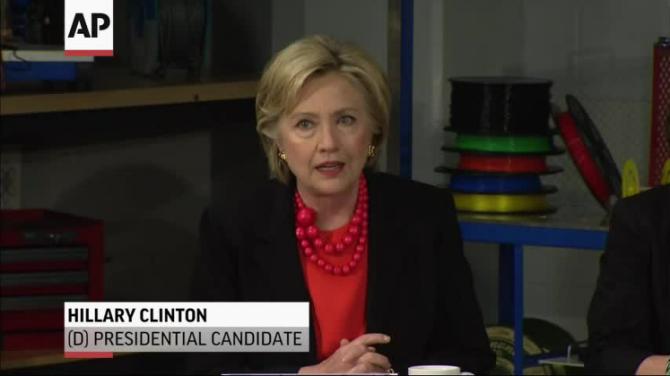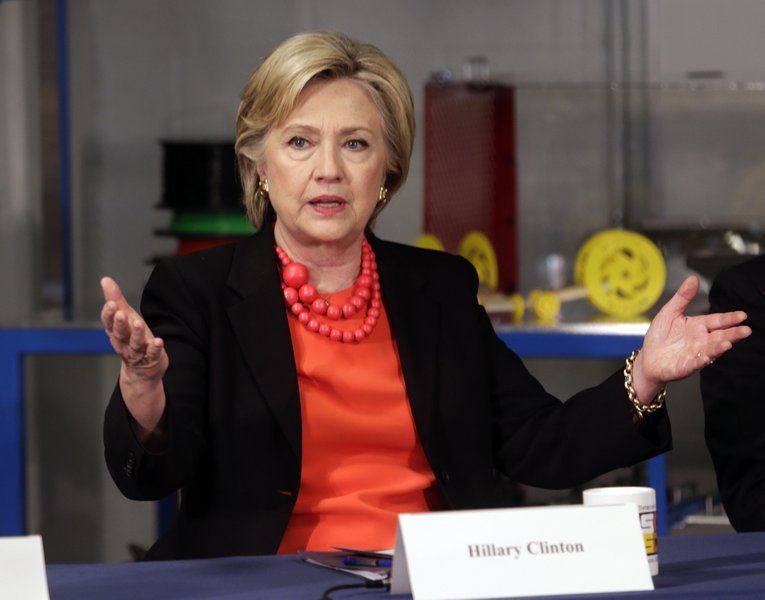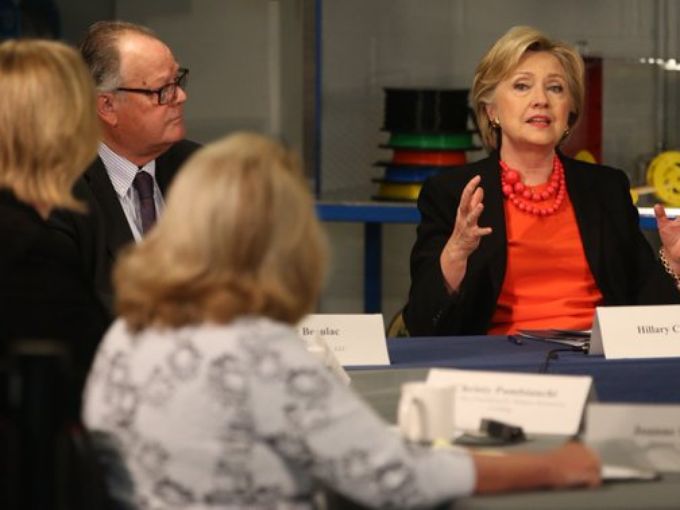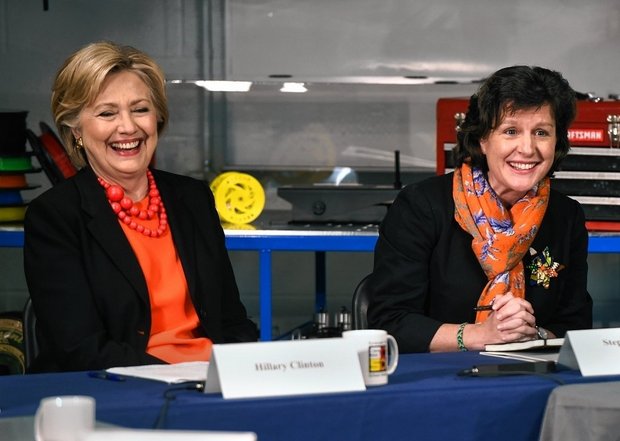Harnessing the Strength of Manufacturing Nationwide, as she did in Upstate New York
Hillary
believes that manufacturing matters because workers who build things
here are the heart of our economy. Well-paying manufacturing jobs
support families, and making things in America here is critical to our
innovation and prosperity. Throughout her career and in this
campaign, Hillary stood up for American manufacturing.
As Senator,
Hillary fought for workers and manufacturers in New York. She stood up
to China when they tried to put tariffs on New York’s exports. In
communities across the state, from Buffalo to Rochester to Albany,
Hillary brought together government at every level, workers,
and businesses large and small to join and invest in good-paying jobs
and production in the state.
Today, in Syracuse, Hillary is
providing more detail on her vision for American manufacturing, with a
$10 billion investment in “Make it in America Partnerships” that
will take her strategy to stand with manufacturers in upstate New York
nationwide. This new proposal will be largely paid for based on revenues
from Clinton’s previously announced “clawback” proposal that would
rescind tax breaks for companies that outsource jobs abroad.
While
too many politicians and experts in Washington gave up on American
manufacturing, Hillary never did. That’s why she believes we need a
comprehensive strategy to break down all the barriers to making things
here, and ensure America’s global leadership in manufacturing. We need
to buy what America makes: hundreds of billions of dollars of investment
in our nation’s infrastructure and making America the world’s clean
energy superpower will drive demand for jobs, equipment, and production
here. And she will oppose trade agreements, like the Trans-Pacific
Partnership, that do not meet her high standards for creating good jobs,
raising wages, and enhancing our national security.
In December
of last year, Hillary put forward five principles for winning the global
race for manufacturing jobs. Today, she is providing more detail on the
principle of harnessing the strength of manufacturing communities
nationwide through “Make it in America” partnerships, and reiterating
the principles she has already discussed throughout this campaign:
1.
Establish “Make it in America Partnerships” that make America the first
choice for manufacturing production by harnessing regional strengths.
Hillary Clinton’s plan will dedicate $10 billion in funding toward
“Make it in America Partnerships” that link together all parts of the
supply chain and build on the strength of a region in particular
industries. Her plan will help make all elements of manufacturing more
innovative and competitive, while encouraging domestic manufacturing and
reshoring. It builds on President Obama’s National Network for
Manufacturing Innovation, and bipartisan legislation written and
spearheaded by Senator Sherrod Brown, one of our nation’s foremost
champions for manufacturing:
o Harness all of a region’s
strengths: Clinton’s plan will use federal resources to take the lead in
bringing together workers, unions, businesses, universities, and
government at every level to harness their combined strengths to
encourage industries to locate in their region, and create jobs and
innovation with wide economic benefits. This approach will help
ideas for new goods and production methods move from university labs to
factory floors to markets across the city, country, and world. This
approach will build up supply chains and “upward spirals” of production,
good-paying jobs, skills, and innovation so that manufacturing
communities across America are the first choice for parts production
and assembly, in everything from steel, cars, and aircraft to wind
turbines and clean energy products.
o A pledge by businesses to
keep jobs and investment in America: Businesses participating in
Hillary’s strategy would pledge not to shift jobs or profits gained from
“Make it in America” incentives to other countries by outsourcing
production, or “inverting” to move their residence abroad and avoid
paying their fair share of U.S. taxes. Hillary’s plan embraces economic
patriotism, and will support companies that invest in their workers
and good-paying jobs here in the U.S. But it won’t support companies
that walk out on America. When America’s incredible innovators come up
with an invention or design, we should also build it here.
o
Promote participation by smaller manufacturers to build up the entire
manufacturing ecosystem and supply chains: “Make it in America”
partnerships would include participation by and sharing with smaller
manufacturers throughout a region, so they learn the skills they need to
thrive and participate profitably in the supply chain. This
could include “test and learn” demonstration centers where small
manufacturers could learn cutting-edge techniques, or “teaching
hospitals” where workers, university and community college experts, and
students could learn new skills from each other. That way, we will help
small manufacturers become links in the global supply chain so we build
things here.
o Create good-paying jobs without stealing them from
other regions, or undermining labor and “Buy America” standards:
Hillary’s proposal will only reward plans that create good-paying jobs.
She will not reward regions that simply relocate jobs or production from
one community to another. And across her proposals, as she has
throughout her career, she will support strong “Buy American” standards,
and the right of unions to organize and collectively bargain. Her plan
will not allow proposals that undermine worker rights or strong labor
and domestic sourcing standards – so that the new manufacturing jobs
we create are good, high-paying jobs.
o
Ensure American competitiveness in the global clean energy economy. Clinton
will help American workers and businesses compete for jobs and
investment in the $13.5 trillion global clean energy market and advanced
vehicles and make all American manufacturing more internationally
competitive by improving industrial energy efficiency by one
third within ten years of taking office. Achieving this goal will save
American companies more than $50 billion a year. Clinton will ensure
that American leadership in producing some of the lowest-carbon steel,
aluminum, glass and other materials in the world is recognized in the
market and rewarded in public and private procurement through a new “Buy
Clean” product labeling system.
2. Prevent foreign
countries like China from abusing global trade rules, and reject
trade agreements that do not meet high standards. Hillary will
put American workers first when it comes to trade. She will stand up to
foreign countries like China when they abuse global trade rules and take
action against the theft – physical and virtual – of America’s
inventions:
o Crack down on foreign countries, like China, that
cheat the rules: If foreign countries dump products on our markets, like
China is doing right now with steel, Hillary’s administration will take
countervailing action. She will appoint a new trade prosecutor to keep
other countries honest. She will take on foreign countries that keep
their goods artificially cheap by manipulating their currencies, and
expand our toolbox to include effective new remedies to respond, such as
duties, tariffs, or other measures. And Hillary opposes China’s
efforts to be recognized as a “market economy,” which would defang our
anti-dumping laws.
o Say “no” to new trade agreements that don’t
meet her high bar – including the Trans-Pacific Partnership. Hillary
will hit pause and say “no” to new trade agreements unless they
create American jobs, raise wages, and improve our national security.
After looking at the final terms of the Trans-Pacific Partnership
agreement, including what it contains on currency manipulation and its
weak rules of origin standard for what counts as a car that can
get treaty benefits, she opposed the agreement because it did not meet
her test. And she will hold every future trade agreement to the same
high standard.
o Review the trade agreements we already have on
the books. Hillary has said for almost a decade that we need to
renegotiate NAFTA, and she still believes that today. And she would
review all of our trade agreements with the same scrutiny.
o Fight
for American exports. U.S. exports total more than $2 trillion dollars
and exporters pay workers higher wages. Clinton will support the efforts
of businesses large and small to tap new markets – both at home and
internationally – to support good paying jobs and spur economic growth.
That is why she stands for American workers in the face of misguided
opposition by supporting the Export-Import Bank, and other policies that
drive American exports.
3. Revitalize the hardest-hit manufacturing communities by
preventing downward cycles of lost employment, knowledge, and physical
capital, and encouraging virtuous cycles of new employment and
production:
o Revitalize hard-hit manufacturing communities by
building on her proposal to provide tax relief to encourage investment
in hard-hit areas that have seen jobs and production
depart. Specifically, Clinton’s plan would make areas that have seen or
are about to face significant manufacturing job or plant losses eligible
for new investment tax incentives – called the “Manufacturing
Renaissance Tax Credit” – modeled on the New Markets Tax Credit
to attract new capital, business, and jobs; a zero capital gains option
on long-term investments; and relief for renovating, refurbishing, or
repurposing plants.
o Link this tax relief to a coordinated,
comprehensive, government-wide effort to prevent “downward spirals”
resulting from departing production in hard-hit communities, and
align resources from across agencies to make funds and programs easier
to access.
4. Crack down on companies shipping jobs and
earnings overseas – and create incentives for companies to bring back
jobs to the U.S.
o Claw back the special tax breaks that
corporations received for locating research and production here at home
if they ship jobs overseas, and use the proceeds to invest in America.
o End abusive inversions and impose an “exit tax” on companies that leave America to lower their tax burden.
o
Provide federal support and tax relief for research and innovation in
America, particularly at smaller businesses and startups.
o
Coordinate government efforts within the U.S. and overseas to recruit
and ease the path for companies to bring back jobs to the U.S.
o
Double support for the Manufacturing Extension Partnership, a
public-private partnership that helps smaller American manufacturers
compete.
o Expand access to capital, especially for smaller manufacturers.
5. Invest in America’s manufacturing workforce to ensure that they will always be the best in the world.
America has the potential to win the global competition for
manufacturing jobs by harnessing the incredible talent and skills of its
workforce. That is why Clinton’s plan will:
o Encourage proven,
high-quality training and apprenticeships – including a $1,500 tax
credit for every apprentice hired through a bona-fide apprenticeship
program – while insisting on accountability for employment and earnings
outcomes.
o Expand nationwide credentialing with strong industry
input that can lead to more and better-paying jobs in every state in the
union.
o Build on models that allow federal student aid to be
used toward high-quality career and technical training programs with
promising or proven records—including traditional career and technical
education, and innovative, flexible online programs.
o Provide tuition-free community college, and reduce student debt by allowing students to refinance their loans.
Read more >>>>







